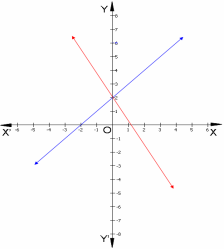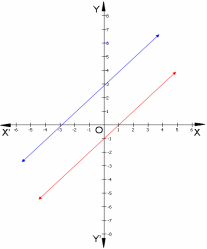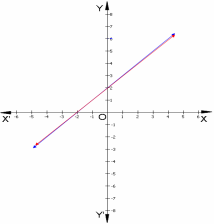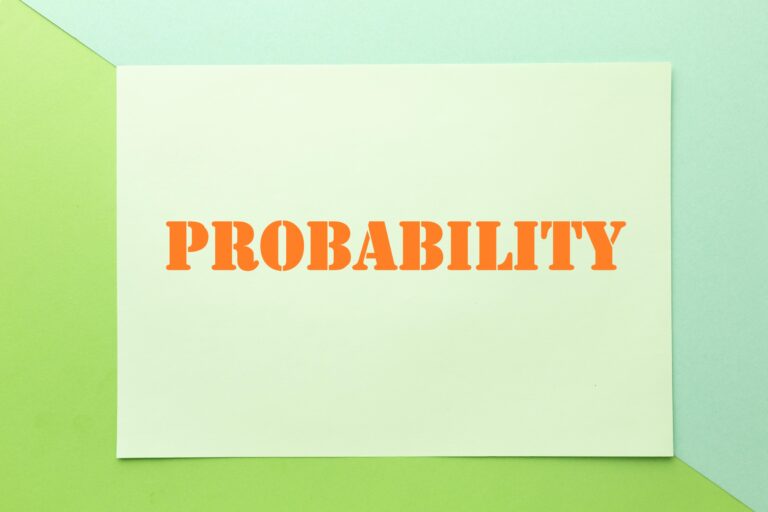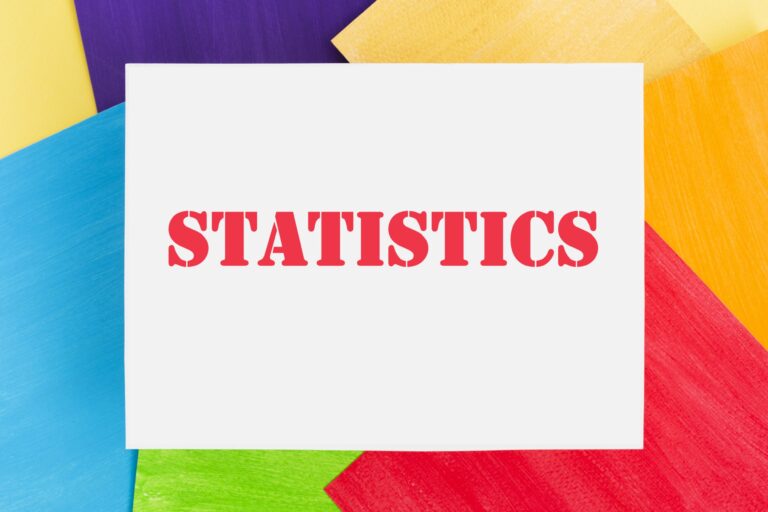
Pair-of-Linear-Equations-in-Two- Variables
Pair of Linear Equations in Two Variables
Geometrical Representation of a Linear Equation
Geometrically, a linear equation in two variables can be represented as a straight line.
2x – y + 1 = 0
⇒ y = 2x + 1

Graph of y = 2x + 1
Plotting a Straight Line
The graph of a linear equation in two variables is a straight line. We plot the straight line as follows:

Linear Polynomial
A polynomial whose degree is one is called a linear polynomial.
For example, 2x+1 is a linear polynomial.
Quadratic Polynomial
A polynomial of degree two is called a quadratic polynomial.
For example, 3x2 + 8x + 5 is a quadratic polynomial.
Cubic Polynomial
A polynomial of degree three is called a cubic polynomial.
For example, 2x3 + 5x2 + 9x + 15 is a cubic polynomial.
For a polynomial of the form y = xn where n is a whole number:
as n increases, the graph becomes steeper or draws closer to the Y-axis
If n is odd, the graph lies in the first and third quadrants
If n is even, the graph lies in the first and second quadrants
The graph of y = −xn is the reflection of the graph of y = xn on the x-axis
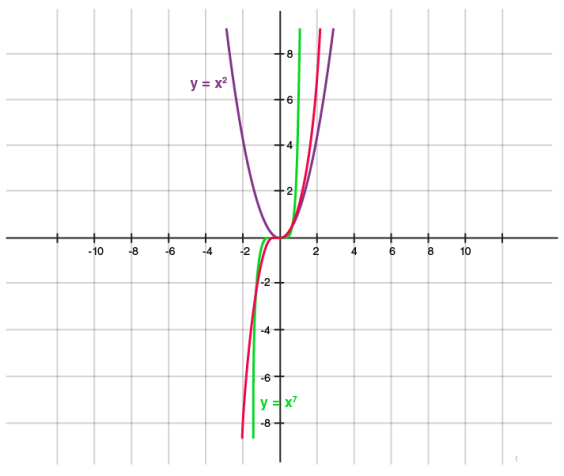
Geometrically, zeros of a polynomial are the points where its graph cuts the x-axis.

(i) One zero (ii) Two zeros (iii) Three zeros
Here A, B and C correspond to the zeros of the polynomial represented by the graphs.
Number of Zeros
In general, a polynomial of degree n has at most n zeros.
a1x + b1y + c1 = 0
a2x + b2y + c2 = 0
where a1, a2, b1, b2, c1 and c2 are real numbers, such that
System of equations can be solved using Algebraic and Graphical Methods.
|
Ratio of Coefficients |
Graphical Representation |
Nature of Solution |
Defined as |
|
a1a2≠b1b2 |
Lines are intersecting
|
Unique solution |
Consistent pair of equations |
|
a1a2=b1b2≠c1c2 |
Lines are parallel
|
No solution |
Inconsistent pair of equations |
|
a1a2=b1b2=c1c2 |
Lines are coincident
|
Infinitely many solutions |
Dependent (consistent) pair of equations |
The most commonly used Algebraic Methods to solve a pair of linear equations in two variables are:
Steps followed for solving linear equations in two variables, using substitution method:
Step 1: Express the value of one variable, say y in terms of other variable x from either equation, whichever is convenient.
Step 2: Substitute the value of y in other equation and reduce it to an equation in one variable, i.e. in terms of x. There will be three possibilities:
Step 3: Substitute the value of x obtained in step 2, in the equation used in step 1, to obtain the value of y.
Step 4: The values of x and y so obtained is the coordinates of the solution of system of equations.
Steps followed for solving linear equations in two variables, by elimination Method:
Step 1: Multiply both the equations by some suitable non-zero constants to make the coefficients of variable x (or y) equal.
Step 2: Add or subtract both the equations to eliminate the variable whose coefficients are equal.
Step 3: Substitute the value of variable y (or x) in either of the equation to get the value of other variable.
Steps followed for solving linear equations in two variables, by cross multiplication method:
Step 1: Write the equations in the general form.
a1x + b1y + c1 = 0
a2x + b2y + c2 = 0
Step 2: Arrange these in the following manner.

Here, the arrows between two numbers (coefficients) mean that they are to be multiplied and the second product is to be subtracted from the first product.
Step 3: Cross multiply:
xb1c2−b2c1=ya2c1−a1c2=1a1b2−a2b1
x=b1c2−b2c1a1b2−a2b1
y=a2c1−a1c2a1b2−a2b1
From the above equations, obtain the value of x and y provided a1b2 – a2b1 ≠ 0.
Reduced equation can be solved by any of the algebraic method (substitution, elimination or cross multiplication) of solving linear equation.
If speed of a boat in still water = u km/hr,
Speed of the current = v km/hr Then,
Speed upstream = (u – v) km/hr
Speed downstream = (u + v) km/hr
Quadratic polynomials can be factorized by splitting the middle term.
For example, consider the polynomial 2x2 − 5x + 3
Splitting the middle term:
The middle term in the polynomial 2×2−5x+3 is -5x. This must be expressed as a sum of two terms such that the product of their coefficients is equal to the product of 2 and 3 (coefficient of x2 and the constant term)
−5 can be expressed as (−2) + (−3), as −2 × −3 = 6 = 2 × 3
Thus, 2x2 − 5x + 3 = 2x2 − 2x − 3x + 3
Now, identify the common factors in individual groups
2x2 − 2x − 3x + 3 = 2x (x−1) – 3 (x−1)
Taking (x−1) as the common factor, this can be expressed as:
2x (x−1) −3 (x−1) = (x−1) (2x−3)
For Quadratic Polynomial:
If α and β are the roots of a quadratic polynomial ax2+bx+c, then,
α + β = -b/a
Sum of zeroes = -coefficient of x /coefficient of x2
αβ = c/a
Product of zeroes = constant term / coefficient of x2
For Cubic Polynomial
If α, β and γ are the roots of a cubic polynomial ax3+bx2+cx+d, then
α + β + γ = -b/a
αβ + βγ + γα = c/a
αβγ = -d/a
To divide one polynomial by another, follow the steps given below.
Step 1: arrange the terms of the dividend and the divisor in the decreasing order of their degrees.
Step 2: To obtain the first term of the quotient, divide the highest degree term of the dividend by the highest degree term of the divisor Then carry out the division process.
Step 3: The remainder from the previous division becomes the dividend for the next step. Repeat this process until the degree of the remainder is less than the degree of the divisor.
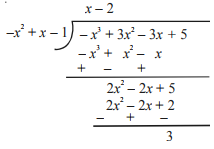
Important Questions
Multiple Choice questions-
1. Graphically, the pair of equations 7x – y = 5; 21x – 3y = 10 represents two lines which are
(a) intersecting at one point
(b) parallel
(c) intersecting at two points
(d) coincident
2. The pair of equations 3x – 5y = 7 and – 6x + 10y = 7 have
(a) a unique solution
(b) infinitely many solutions
(c) no solution
(d) two solutions
3. If a pair of linear equations is consistent, then the lines will be
(a) always coincident
(b) parallel
(c) always intersecting
(d) intersecting or coincident
4. The pair of equations x = 0 and x = 5 has
(a) no solution
(b) unique/one solution
(c) two solutions
(d) infinitely many solutions
5. The pair of equation x = – 4 and y = – 5 graphically represents lines which are
(a) intersecting at (- 5, – 4)
(b) intersecting at (- 4, – 5)
(c) intersecting at (5, 4)
(d) intersecting at (4, 5)
6. One equation of a pair of dependent linear equations is 2x + 5y = 3. The second equation will be
(a) 2x + 5y = 6
(b) 3x + 5y = 3
(c) -10x – 25y + 15 = 0
(d) 10x + 25y = 15
7.If x = a, y = b is the solution of the equations x + y = 5 and 2x – 3y = 4, then the values of a and b are respectively
(a) 6, -1
(b) 2, 3
(c) 1, 4
(d) 19/5, 6/5
8. The graph of x = -2 is a line parallel to the
(a) x-axis
(b) y-axis
(c) both x- and y-axis
(d) none of these
9. The graph of y = 4x is a line
(a) parallel to x-axis
(b) parallel to y-axis
(c) perpendicular to y-axis
(d) passing through the origin
10. The graph of y = 5 is a line parallel to the
(a) x-axis
(b) y-axis
(c) both axis
(d) none of these
Very Short Questions:
x + 2y – 8 = 0, 2x + 4y = 16
2ax + by = a, 4ax + 2by – 2a = 0; a, b≠ 0
x – 2y = 8, 5x + 10y = c
have a unique solution. Justify whether it is true or false.
x2+ y +25= 0, 4x+ 8y +516= 0.
9x – 10y = 14
Short Questions :
152x – 378y = -74 and -378x + 152y = -604
![]()
2x + 3y = 7
(a – b)x + (a + b)y = 3a + b – 2
(ii) for which value of k will the following pair of linear equations have no solution?
3x + y = 1
(2k – 1)x + (k – 1)y = 2k + 1
7x – 4y = 49 and 5x – y = 57
![]()
![]()
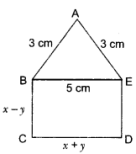
Long Questions :
2x + 4y = 10 and 3x + 6y = 12 has no solution.
(i) 3x – 5y – 4 = 0 and 9x = 2y + 7
(ii) x2+2y3 = −1 and x –y3 = 3
Case Study Questions:

Considering the fixed charges per month by ₹ x and the cost of food per day by ₹ y, then answer the following questions.

Consider the fares from Bengaluru to Malleswaram and that to Yeswanthpur as ₹ x and ₹ y respectively and answer the following questions.
Assertion reason questions-
Assertion: The graph of the linear equations 3x+2y=12 and 5x-2y=4 gives a pair of intersecting lines.
Reason: The graph of linear equations a1x + b1y + c1 = 0 and a2x + b2y + c2 = 0 gives a pair of intersecting lines if a1/a2 ≠ b1/b2
Assertion: If the pair of lines are coincident, then we say that pair of lines is consistent and it has a unique solution.
Reason: If the pair of lines are parallel, then the pairs has no solution and is called inconsistent pair of equations.
Answer Key-
Multiple Choice questions-
Very Short Answer :
![]()
∴ For no value of c, the given system of equations have infinitely many solutions.

Given equations do not represent a pair of coincident lines.
∴0 – y = 8 ⇒ y = -8
Required coordinate is (0, -8).
![]()

∴The given pair of linear equations has infinitely many solutions.

∴ The given system of equations is consistent.

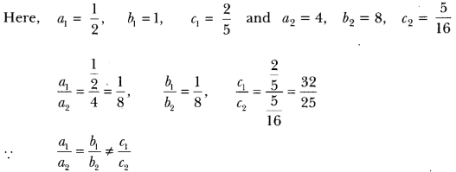
∴ The given system does not represent a pair of coincident lines.
x – y = 2 … (i)
x + y = 4 … (ii)
From (i), 3 – y ⇒ 2 = y = 1
a = 3, b = 1.
On comparing the ratios a1a2,b1b2 , and, c1c2 find out whether the following pair of linear equations consistent or inconsistent. is consistent or inconsistent.
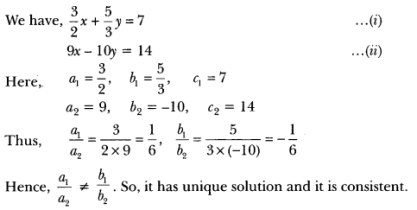
Short Answer :
ax + by – (a – b) = 0
bx – ay – (a + b) = 0
By cross-multiplication, we have
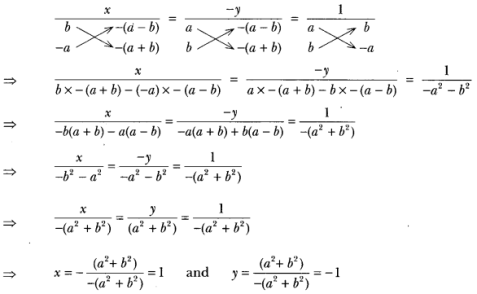
Hence, the solution of the given system of equations is x = 1, y = -1
-378x + 152y = -604 ……(ii)
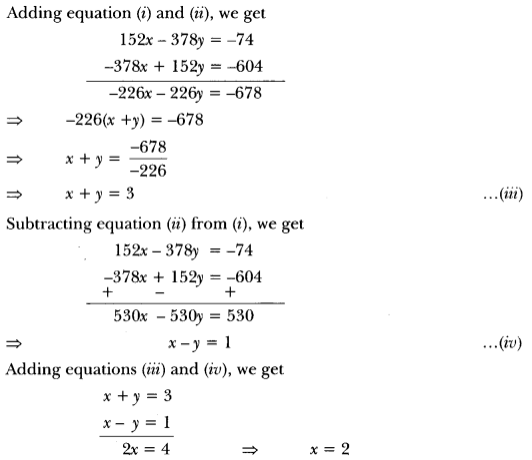
Putting the value of x in (iii), we get
2 + y = 3 ⇒ y = 1
Hence, the solution of given system of equations is x = 2, y = 1.



(a – b) x + (a + b) y = 3a + b – 2 … (ii)
Here, a1 = 2, b1 = 3, c1 = 7 and
a2 = a – b, b2 = a + b, c2 = 3a + b – 2
For infinite number of solutions, we have
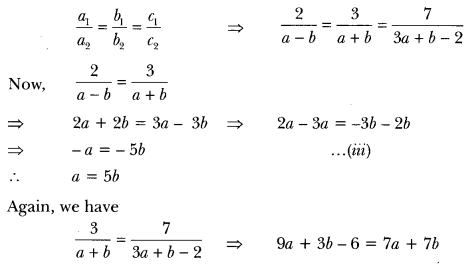
⇒ 9a – 7a + 3b – 75 -6 = 0 ⇒ 2a – 45 – 6 = 0 => 2a – 4b = 6
⇒ a – 2b = 3 …(iv)
Putting a = 5b in equation (iv), we get
56 – 2b = 3 or 3b = 3 i.e., b = 33 =1
Putting the value of b in equation (ii), we get a = 5(1) = 5
Hence, the given system of equations will have an infinite number of solutions for a = 5 and b = 1.
(ii) We have, 3x + y = 1, 3x + y − 1 = 0 …(i)
(2k – 1) x + (k – 1) y = 2k + 1
⇒ (2k – 1) x + (k – 1) y – (2k + 1) = 0 ……(ii)
Here, a1 = 3, b1 = 1, C1 = -1
a2 = 2k – 1, b2 = k – 1, C2 = -(2k + 1)
For no solution, we must have

⇒ 3k – 2k = 3 – 1 ⇒ k = 2
We have, 7x – 4y = 49 ……..(i)
and 5x – 6y = 57 ……..(ii)
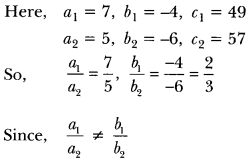
So, system has a unique solution.
Multiply equation (i) by 5 and equation (ii) by 7 and subtract

Put y = -7 in equation (ii)
5x – 6(-7)57 ⇒ 5x = 57 – 42 ⇒ x = 3
hence, x = 3 and y = -7.
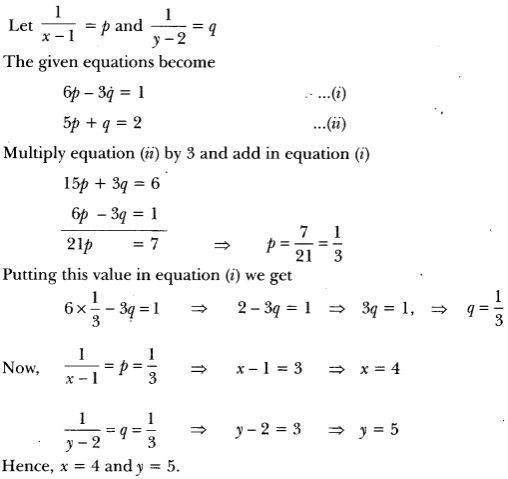
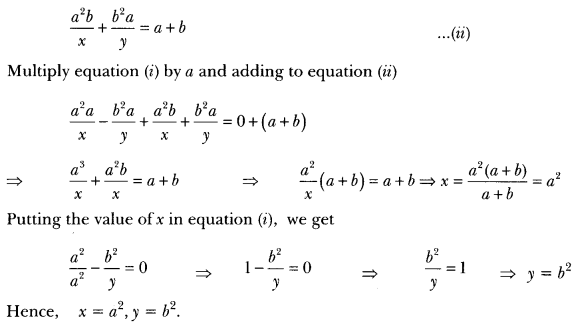
(Sum of interior angles of A ABC) x + 3x + y = 180°
4x + y = 180° …(i)
3y – 5x = 30° (Given) …(ii) Multiply equation (i) by 3 and subtracting from eq. (ii), we get
-17x = – 510 = x = 910 = 30°
17 then _A = x = 30° and 2B = 3x = 3 X 30o = 90°
∠C = y = 180° – (∠A + ∠B) = 180° – 120° = 60°
∠A = 30°, ∠B = 90°, ∠C = 60° Hence ∆ABC is a right triangle right angled at B.
BCDE is a rectangle.
Opposite sides are equal BE = CD
∴ x + y = 5 …… (i)
DE = BC = x – y
Since the perimeter of ABCDE is 21 cm.
AB + BC + CD + DE + EA = 21
3 + x – y + x + y + x – y + 3 = 21 ⇒ 6 + 3x – y = 21
3x – y = 15 ….. (iii)
Adding (i) and (ii), we get
4x = 20 ⇒ x = 5
On putting the value of x in (i), we get y = 0
Hence, x = 5 and y = 0.
B’s age 5 years ago = (x – 5) years
and A’s age 5 years ago = (- 5) years
(-5) = 3 (x – 5) = 3x – y = 10 …….(i)
B’s age 10 years hence = (x + 10) years
A’s age 10 years hence = (y + 10) years
y + 10 = 2 (x + 10) = 2x – y = -10 …….. (ii)
On subtracting (ii) from (i) we get x = 20
Putting x = 20 in (i) we get
(3 × 20) – y = 10 ⇒ y = 50
∴ x = 20 and y = 50
Hence, B’s present age = 20 years and A’s present age = 50 years.
Long Answer :
According to question, we have
x = y + 4
⇒ x – y = 4 ……(i)
Again, total number of students = 10
Therefore, x + y = 10 …(ii)
Hence, we have following system of equations
x – y = 4
and x + y = 10
From equation (i), we have the following table:

From equation (ii), we have the following table:

Plotting this, we have
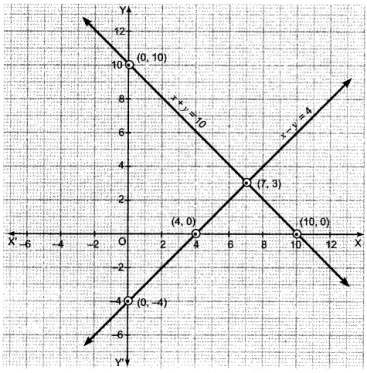
Here, the two lines intersect at point (7,3) i.e., x = 7, y = 3.
So, the number of girls = 7
and number of boys = 3.
⇒ 4y = 10 – 2x ⇒ y = 5−x2
Thus, we have the following table:

Plot the points A (1, 2), B (3, 1) and C (5,0) on the graph paper. Join A, B and C and extend it on both sides to obtain the graph of the equation 2x + 4y = 10.
We have, 3x + 6y = 12
⇒ 6y = 12 – 3x ⇒ y = 4−x2
Thus, we have the following table :

Plot the points D (2, 1), E (0, 2) and F (4,0) on the same graph paper. Join D, E and F and extend it on both sides to obtain the graph of the equation 3x + 6y = 12.
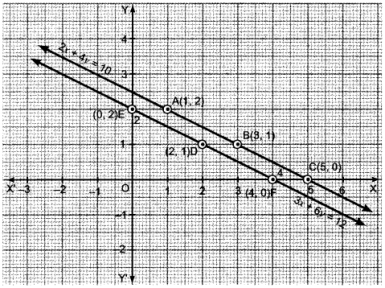
We find that the lines represented by equations 2x + 4y = 10 and 3x + y = 12 are parallel. So, the two lines have no common point. Hence, the given system of equations has no solution.
⇒ 3x – 5y = 4 …….(i)
Again, 9x = 2y + 7
9x – 2y = 7 …(ii)
By Elimination Method:
Multiplying equation (i) by 3, we get
9x – 15y = 12 … (iii)
Subtracting (ii) from (iii), we get

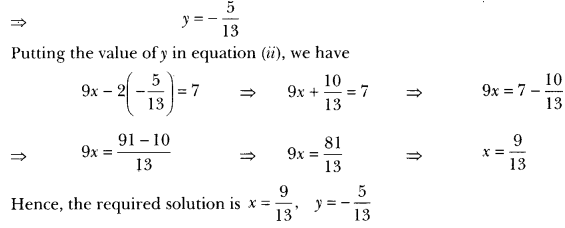
By Substitution Method:
Expressing x in terms of y from equation (i), we have
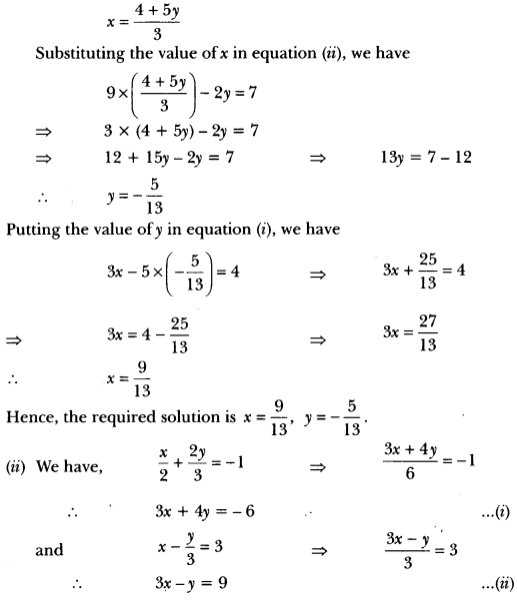
By Elimination Method:
Subtracting (ii) from (i), we have
5y = – 15 or y = – 55 = -3
Putting the value of y in equation (i), we have
3x + 4 × (-3) = -6 ⇒ 3x = – 6 + 12
∴ 3x – 12 = -6 ⇒ 3x = 6
∴ x = 63 = 2
Hence, solution is x = 2, y = -3.
By Substitution Method:
Expressing x in terms of y from equation (i), we have
![]()
Substituting the value of x in equation (ii), we have
∴ -5y = 9 + 6 = 15
y = –155 = – 3
Putting the value of y in equation (i), we have
3x + 4 × (-3) = -6 ⇒ 3x – 12 = -6
∴ 3x = 12 – 6 = 6
∴ x = 63 = 2
Hence, the required solution is x = 2, y = – 3.
Thus, x – y = -1 => x = y – 1 …(i)
3x + 2y = 12 => x = 12−2y3 … (ii)
From equation (i), we have

From equation (ii), we have

Plotting this, we have

ABC is the required (shaded) region and point of intersection is (2, 3).
∴ The vertices of the triangle are (-1, 0), (4, 0), (2, 3).
Therefore, according to question,
x + 20y = 1000 …(i)
x + 26y = 1180 …(ii)
Now, subtracting equation (ii) from (i), we have
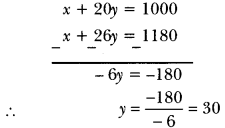
Putting the value of y in equation (i), we have
x + 20 x 30 = 1000 ⇒ x + 600 = 1000 ⇒ x = 1000 – 600 = 400
Hence, fixed charge is ₹400 and cost of food per day is ₹30.
According to question,
3x – y = 40 … (i)
and 4x – 2y = 50
or 2x – y = 25 …(ii)
Subtracting (ii) from (i), we have

Putting the value of x in equation (i), we have
3 x 15 – y = 40 ⇒45 – y = 40
∴ y = 45 – 40 = 5
Hence, total number of questions is x + i.e.., 5 + 15 = 20.

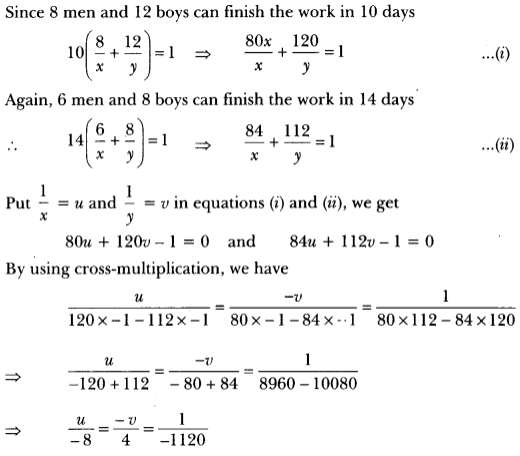
Hence, one man alone can finish the work in 140 days and one boy alone can finish the work in 280 days.
Speed upstream (x – y) km/h
Speed downstream (x + y) km/h
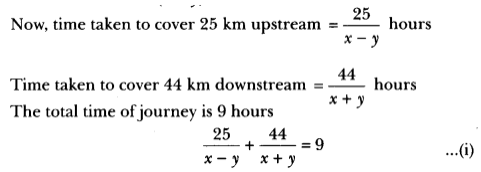


25u + 44v = 9 ⇒ 25u + 44v – 9 = 0 …(iii)
15u + 22v = 5 ⇒ 15u + 22v – 5 = 0 …(iv)
By cross-multiplication, we have


Solving equations (v) and (vi), we get x = 8 and y = 3.
Hence, speed of the boat in still water is 8 km/h and speed of the stream is 3 km/h.
Case Study Answers:
Solution:
For student Anu:
Fixed charge + cost of food for 25 days = ₹ 4500
i.e., x + 25y = 4500
For student Bindu:
Fixed charges + cost of food for 30 days = ₹ 5200
i.e., x + 30y = 5200
Solution:
From above, we have a1= 1, b1 = 25
c1 = -4500 and a2 = 1, b2 = 30, c2 = -5200

Thus, system of linear equations has unique solution.
Solution:
We have, x + 25y = 4500
and x + 30y = 5200
Subtracting (i) from (ii), we get
5y = 700 ⇒ y = 140
∴ Cost of food per day is ₹ 140
Solution:
We have, x + 25y = 4500
⇒ x = 4500 – 25 × 140
⇒ x = 4500 – 3500 = 1000
∴ Fixed charges per month for the hostel is ₹ 100
Solution:
We have, x = 1000, y = 140 and Bindu takes food for 20 days.
∴ Amount that Bindu has to pay = ₹ (1000 + 20 × 140) = ₹ 3800
Solution:
1st situationcan berepresented algebraically as.
2x + 3y = 46
Solution:
2nd situation can be represented algebraically as:
3x + 5y = 74
Solution:
We have, 2x + 3y = 46………(i)
3x + 5y = 74………(ii)
Multiplying (i) by 5 and (ii) by 3 and then subtracting, we get
10x – 9x = 230 – 222 ⇒ x = 8
∴ Fare from Bengaluru to Malleswaram is ₹ 8.
Solution:
Putting the value of x in equation (i), we g
3y = 46 – 2 × 8 = 30 ⇒ y = 10
∴ Fare from Bengaluru to Yeswanthpur is ₹ 10
Solution:
We have, a1= 2, b1 = 3, c1 = -46 and
a2 = 3, b2 = 5, C2 = -74

Thus system of linear equations has unique solution.
Assertion reason Answer-
